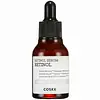What's inside
What's inside
 Key Ingredients
Key Ingredients

 Benefits
Benefits

 Concerns
Concerns

 Ingredients Side-by-side
Ingredients Side-by-side

Calendula Officinalis Extract
Skin ConditioningButylene Glycol
HumectantGlycerin
HumectantHelianthus Annuus Seed Oil
Emollient1,2-Hexanediol
Skin ConditioningPolysorbate 60
EmulsifyingBetaine
HumectantDimethicone
EmollientCetearyl Alcohol
EmollientRetinyl Palmitate
Skin ConditioningCetearyl Olivate
Panthenol
Skin ConditioningArachis Hypogaea Oil
Skin ConditioningSorbitan Olivate
EmulsifyingAllantoin
Skin ConditioningTocopheryl Acetate
AntioxidantHydroxyethyl Acrylate/Sodium Acryloyldimethyl Taurate Copolymer
Emulsion StabilisingHydroxyethylcellulose
Emulsion StabilisingXanthan Gum
EmulsifyingJuniperus Mexicana Oil
MaskingEthylhexylglycerin
Skin ConditioningAdenosine
Skin ConditioningTocopherol
AntioxidantCalendula Officinalis Extract, Butylene Glycol, Glycerin, Helianthus Annuus Seed Oil, 1,2-Hexanediol, Polysorbate 60, Betaine, Dimethicone, Cetearyl Alcohol, Retinyl Palmitate, Cetearyl Olivate, Panthenol, Arachis Hypogaea Oil, Sorbitan Olivate, Allantoin, Tocopheryl Acetate, Hydroxyethyl Acrylate/Sodium Acryloyldimethyl Taurate Copolymer, Hydroxyethylcellulose, Xanthan Gum, Juniperus Mexicana Oil, Ethylhexylglycerin, Adenosine, Tocopherol
Water
Skin ConditioningGlycerin
HumectantAlcohol Denat.
AntimicrobialIsononyl Isononanoate
EmollientPentylene Glycol
Skin ConditioningDicaprylyl Ether
EmollientGlycine Soja Oil
EmollientPropylene Glycol
HumectantPEG-6 Caprylic/Capric Glycerides
EmulsifyingCitric Acid
BufferingPentaerythrityl Tetra-Di-T-Butyl Hydroxyhydrocinnamate
AntioxidantSodium Hyaluronate
HumectantTrisodium Ethylenediamine Disuccinate
Retinol
Skin ConditioningDicaprylyl Carbonate
EmollientAmmonium Polyacryloyldimethyl Taurate
Emulsion StabilisingButylene Glycol
HumectantCaprylyl Glycol
EmollientGlyceryl Isostearate
EmollientPPG-6-Decyltetradeceth-30
EmulsifyingTocopherol
AntioxidantXanthan Gum
EmulsifyingBenzyl Alcohol
PerfumingCitronellol
PerfumingIsoeugenol
PerfumingLimonene
PerfumingLinalool
PerfumingPhenoxyethanol
PreservativeParfum
MaskingWater, Glycerin, Alcohol Denat., Isononyl Isononanoate, Pentylene Glycol, Dicaprylyl Ether, Glycine Soja Oil, Propylene Glycol, PEG-6 Caprylic/Capric Glycerides, Citric Acid, Pentaerythrityl Tetra-Di-T-Butyl Hydroxyhydrocinnamate, Sodium Hyaluronate, Trisodium Ethylenediamine Disuccinate, Retinol, Dicaprylyl Carbonate, Ammonium Polyacryloyldimethyl Taurate, Butylene Glycol, Caprylyl Glycol, Glyceryl Isostearate, PPG-6-Decyltetradeceth-30, Tocopherol, Xanthan Gum, Benzyl Alcohol, Citronellol, Isoeugenol, Limonene, Linalool, Phenoxyethanol, Parfum
 Reviews
Reviews

Ingredients Explained
These ingredients are found in both products.
Ingredients higher up in an ingredient list are typically present in a larger amount.
Butylene Glycol (or BG) is used within cosmetic products for a few different reasons:
Overall, Butylene Glycol is a safe and well-rounded ingredient that works well with other ingredients.
Though this ingredient works well with most skin types, some people with sensitive skin may experience a reaction such as allergic rashes, closed comedones, or itchiness.
Learn more about Butylene GlycolGlycerin is already naturally found in your skin. It helps moisturize and protect your skin.
A study from 2016 found glycerin to be more effective as a humectant than AHAs and hyaluronic acid.
As a humectant, it helps the skin stay hydrated by pulling moisture to your skin. The low molecular weight of glycerin allows it to pull moisture into the deeper layers of your skin.
Hydrated skin improves your skin barrier; Your skin barrier helps protect against irritants and bacteria.
Glycerin has also been found to have antimicrobial and antiviral properties. Due to these properties, glycerin is often used in wound and burn treatments.
In cosmetics, glycerin is usually derived from plants such as soybean or palm. However, it can also be sourced from animals, such as tallow or animal fat.
This ingredient is organic, colorless, odorless, and non-toxic.
Glycerin is the name for this ingredient in American English. British English uses Glycerol/Glycerine.
Learn more about GlycerinTocopherol (also known as Vitamin E) is a common antioxidant used to help protect the skin from free-radicals and strengthen the skin barrier. It's also fat soluble - this means our skin is great at absorbing it.
Vitamin E also helps keep your natural skin lipids healthy. Your lipid skin barrier naturally consists of lipids, ceramides, and fatty acids. Vitamin E offers extra protection for your skin’s lipid barrier, keeping your skin healthy and nourished.
Another benefit is a bit of UV protection. Vitamin E helps reduce the damage caused by UVB rays. (It should not replace your sunscreen). Combining it with Vitamin C can decrease sunburned cells and hyperpigmentation after UV exposure.
You might have noticed Vitamin E + C often paired together. This is because it is great at stabilizing Vitamin C. Using the two together helps increase the effectiveness of both ingredients.
There are often claims that Vitamin E can reduce/prevent scarring, but these claims haven't been confirmed by scientific research.
Learn more about TocopherolXanthan gum is used as a stabilizer and thickener within cosmetic products. It helps give products a sticky, thick feeling - preventing them from being too runny.
On the technical side of things, xanthan gum is a polysaccharide - a combination consisting of multiple sugar molecules bonded together.
Xanthan gum is a pretty common and great ingredient. It is a natural, non-toxic, non-irritating ingredient that is also commonly used in food products.
Learn more about Xanthan Gum